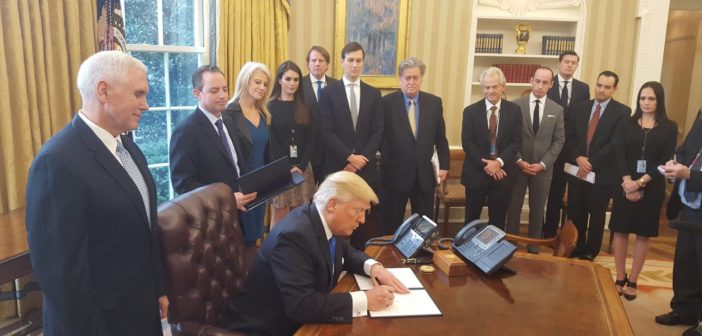President Donald Trump has recently signed his new-and-improved travel ban executive order; this time behind closed doors without a photo-op in sight. The new order is a direct revision of the initial one that was struck down early last month by the Ninth Circuit after a sloppy implementation and lack of certainty among federal agencies led to chaos at airports. Some passengers were in the air when it took effect and were shocked to find themselves denied entry or detained once they touched down. ABC News reported more than two dozen were detained at airports from Fort Worth, Texas, to New York.
Instead of appealing the original executive order to the Supreme Court, which President Trump threatened in all-caps on his Twitter page, the White House opted for the quieter route and simply drew up another. The new order will take effect on March 16, with the White House allowing the 10-day delay to curtail the hurricane that followed the original.
The question that is being asked now is: will this action be held up, or will another federal judge have a case to suspend this one as well?
There are differences between the two orders, but not drastic ones. Stephen Miller, senior White House policy advisor, on FOX News’ “First 100 Days” said that the new order would have “mostly minor technical differences,” in response to the court’s ruling, which Miller called “erroneous.” Miller went on to say, “fundamentally you are still going to have the same basic policy outcome for the country.”
Those minor technical differences include several details that were contested about the first order. The new order effectively exempts those who have valid green cards and visas, which sparked confusion under the first order. The Syrian refugees who were banned indefinitely by the original order are now subject to the same 120-day ban as all other refugees.
Iraq has been dropped from the list after the Iraqi government and the U.S. State Department were able to come to terms over vetting procedures, and, most importantly for court hearings, the order discarded the language that favored persecuted religious minorities.
Certainly many progressive groups who were vehemently opposed and called for the revoking of the first order are still opposed to this version. But, the important part for both sides is whether it can legally hold water.
MSNBC’s “Morning Joe” host and former congressman Joe Scarborough spoke on Wednesday about how much weaker the case against the order now is. Scarborough cited that the seven countries (now six) that were chosen for the ban were selected bipartisanly by Congress during the Obama administration as the nations that posed the greatest threat when it came to giving out visas.
“Every court that is reasonable and rational would see that as something that depends on actual data,” said Scarborough. “At least the serious judges I have known my entire life are actually going to look what’s on the paper.”
The dropped language that seemingly favored Christian minorities could be a big hurdle for judges looking to upend the order. This language was the basis as to why some groups saw the executive order as an effective Muslim ban, as they are the religious majority in those nations; and candidate Trump had previously campaigned for a “Muslim ban” before shifting his rhetoric to “extreme vetting,” near the latter portion of the campaign.
With all of that now erased from the travel ban, it will be curious to see the route in which attorney generals and federal judges take if they opt to fight it. Will they be able to cite former New York Mayor Rudy Giuliani, who told FOX News in January that President Trump asked for help creating a legal Muslim ban? Will they use Stephen Miller’s words against him?
This week, Hawaii became the first state to attempt to sue over the new travel ban. State attorneys said that the order would cause extensive harm to Hawaii’s Muslim population and its economy that relies heavily on tourism. Attorney General Douglas Chin also said that the order is, “nothing more than Muslim ban 2.0.” Since then, other states have vowed to step in, including New York, Oregon and Washington, which was the state that initially challenged the first order as well.
It will be even more fascinating to hear the arguments from both sides on this new order. Some groups will say that it is essentially the same ban, others will counter that the order has been appropriately tightened up.
Nevertheless, how different or how succinct the executive order may be; it only takes one federal judge in the circuit to rule in one of the states’ favor to suspend the whole thing.

